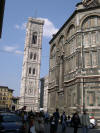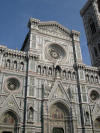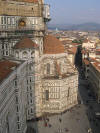
Venice
 Grand Canal with Doge's Palace in Restoration (on right)
Grand Canal with Doge's Palace in Restoration (on right)
Florence (Firenze)
 The Bell-Tower (Campanile)
of the Duomo
The Bell-Tower (Campanile)
of the Duomo
"Designed by the painter Giotto di Bondone in 1334 (and
completed with some minor modifications after his death), the
Florence campanile stands apart from the cathedral in the
Italian tradition. In fact, it could stand anywhere else
in Florence without looking out of place; it is essentially
self-sufficient. ... Neatly subdivided into cubic
sections, Giotto's tower is the sum of its clearly distinguished
parts. This compartmentalization is reminiscent of the
Romanesque
style, but it also forecasts the ideals of Renaissance
architecture. Artists hoped to express structure in the
clear logical relationships of the component parts and to
produce self-sufficient works that could exist in complete
independence."
- Gardner's
Art Through The Ages,
11th edition, Vol. II, p. 547
 Florence Baptistery with a view of the Duomo behind
Florence Baptistery with a view of the Duomo behind
 South Doors of the Florence
Baptistery - Presentation of the Head of John the Baptist to
Salome by Andrea Pisano (1330 - 1336)
South Doors of the Florence
Baptistery - Presentation of the Head of John the Baptist to
Salome by Andrea Pisano (1330 - 1336)
"The Republic of Florence was a dominant city-state during the
fourteenth century. ... Florentines prided themselves on
what they perceived as economic and cultural superiority.
They translated their pride into landmark buildings such as
Florence Cathedral [the Duomo]. Recognized as the center
for the most important religious observances in Florence, the
cathedral was begun in 1296 by Arnolfo di Cambio. Intended
as the "most beautiful and honorable church in Tuscany," this
structure reveals the competitiveness the Florentines felt with
such cities as Siena and Pisa. Cathedral authorities planned for
the church to hold the city's entire population, and although it
only holds about thirty thousand (Florence's population at the
time was slightly less than one-hundred thousand), it seemed so
large that even the noted architect Leon Battista Alberti
commented that it seemed to cover "all of Tuscany with its
shade." ... The vast gulf that separates this
Italian church from its northern European counterparts is
strikingly evident when the former is compared with a full-blown
German representative of the High Gothic style, such as [Strasbourg
Cathedral]."
- Gardner's
Art Through The Ages,
11th edition, Vol. II, p. 546
 Duomo Facade
Duomo Facade
 View of the Duomo from the Campanile
View of the Duomo from the Campanile
"[Compared to the Gothic fancy of the
Strasbourg Cathedral]...
Florence Cathedral clings to the ground and has no aspirations
to flight. All emphasis is on the design's horizontal elements,
and the building rests firmly and massively on the ground.
Simple geometric volumes are defined clearly and show no
tendency to merge either into each other or into the sky.
The dome, though it may seem to be rising because of its ogival
section, has a crisp, closed silhouette that sets it off
emphatically against the sky behind it. ... [This] dome is
the monument with which architectural historians usually
introduce the Renaissance (it was built by Filippo Brunelleschi
between 1420 and 1436)..."
- Gardner's
Art Through The Ages,
11th edition, Vol. II, pp. 546 - 547
 The Duomo from the Campanile (Florence)
The Duomo from the Campanile (Florence)
"Brunelleschi's broad knowledge of Roman construction
principles, combined with an analytical and inventive mind,
permitted him to solve an engineering problem that no other
fifteenth-century architect could have solved. The
challenge was the design and construction of a dome for the huge
crossing of the unfinished Florence Cathedral. The problem
was staggering; the space to be spanned (one hundred fourty
feet) was much too wide to permit construction with the aid of
traditional wooden centering. Nor was it possible, because
of the crossing plan, to support the dome with buttressed walls.
Brunelleschi seems to have begun work on the problem about 1417.
In 1420, officials overseeing cathedral projects awarded
Brunelleschi and Ghiberti a joint commission. The latter,
however, soon retired from the project and left the field to his
associate.
"With exceptional ingenuity, Brunelleschi not only discarded
traditional building methods and devised new ones, but he also
invented much of the machinery necessary for the job.
Although he might have preferred the hemispheric shape of Roman
domes, Brunelleschi raised the center of his dome and devised it
around an ogival (pointed arch) section, which is inherently
more stable because it reduces the outward thrust of the dome's
base. To minimize the structure's weight, he designed a
relatively thin double-shell (the first in history) around a
skeleton of twenty-four ribs. The eight most important are
visible on the exterior. Finally, in almost paradoxical
fashion, Brunelleschi anchored the structure at the top with a
heavy lantern, built after his death, but from his design."
- Gardner's
Art Through The Ages,
11th edition, Vol. II, p. 606
|